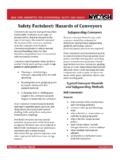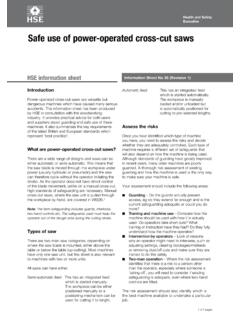Transcription of OSHA Standards on Machine Guarding
1 MGC osha Standards Outline osha Standards on Machine Guarding The osha Standards on general Guarding of machinery and mechanical power transmission apparatus (29 CFR and ) are very broad and generally minimum Guarding Standards . One standard was predicated on the 1970 s version of the ANSI/ASME standard, which itself had undergone several revisions (with 2000 as the most recent) before transfer to another ANSI-accredited Standards Developing Organization. The current and most authoritative standard on the broad subject of safeguarding for machinery is ANSI ; this modern and significantly revised version of the standard also incorporates (and updated) the requirements of the ASME standard, which was formally withdrawn in 2011.
2 The ANSI standard specifies requirements for both safeguarding suppliers and users, and includes detailed requirements on general safeguarding concepts ( , safe distance safeguarding), guards (fixed, adjustable and interlocked), safeguarding devices, awareness barriers/signals/signs, safeguarding methods, safe work procedures, and on safeguarding inspection, maintenance and training. Nine informative annexes provide much additional and useful guidance. Example requirements found in ANSI about guards: a) Material used in the construction of guards shall be of such design and strength as to protect individuals from identified hazards; b) Guards shall be free of sharp edges, burrs, slag welds, fasteners, or other hazards that may injure individuals when handling, removing or using the guards or equipment; c) Handles placed on guards shall be secured to the guard so as not to create a pinch point between the handles and the guard, frame or Machine ; d) The design and construction of the guard shall ensure that individuals cannot reach the hazard by reaching over, under, around, or through the guard.
3 E) Guards shall be designed and constructed so as to ensure ease of use; f) The guard shall be designed and constructed to provide visibility of the hazard zone appropriate to the particular operation; g) Transparent guards shall provide the appropriate level of protection as determined by the risk assessment; h) The supplier shall provide a maintenance or replacement schedule or criteria to determine transparent guard replacement in their information for use; i) Interlocked guards shall be designed and constructed to meet the following additional requirements: i. Interlock devices used in conjunction with guards shall be specifically designed and constructed for use in safeguarding applications; ii. Guard locking devices, when used, shall prevent the guard from being opened and shall prevent access to the hazard until the command has been given to release the guard.
4 The risk assessment shall determine the need for a means to unlock the guard locking device or otherwise provide a means of egress from inside the safeguarded area; iii. Interlock blocking devices, when used, shall prevent energizing the safety related circuit by securing or locking in an open position.






